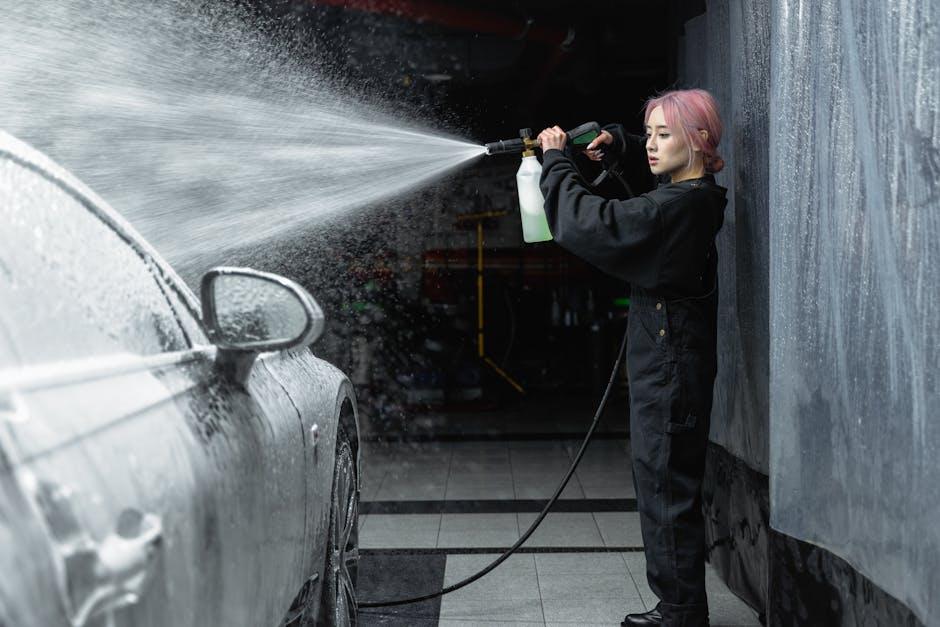In the intricate dance of automotive maintenance, few tasks are as crucial yet often overlooked as flushing your vehicle’s transmission fluid. Like the lifeblood that keeps your engine’s gears shifting smoothly, fresh transmission fluid ensures optimal performance and longevity. However, knowing how to flush it properly can mean the difference between a seamless glide and costly repairs. This article will guide you through the essential steps and best practices to perform a transmission fluid flush safely and effectively — keeping your ride running as smoothly as the first day you drove it.
Table of Contents
- Choosing the Right Transmission Fluid for Your Vehicle
- Preparing Your Vehicle for a Safe Transmission Fluid Flush
- Step-by-Step Guide to Flushing Transmission Fluid Efficiently
- Common Mistakes to Avoid During the Transmission Fluid Flush
- Benefits of Regular Transmission Fluid Maintenance
- When to Seek Professional Help for Transmission Fluid Services
- Q&A
- To Wrap It Up

Choosing the Right Transmission Fluid for Your Vehicle
Selecting the ideal transmission fluid is essential to maintaining the health and performance of your vehicle’s transmission system. Not all fluids are created equal, and using the wrong type can lead to inefficient shifting, increased wear, and even damage. When choosing, consider the manufacturer’s specifications stated in the owner’s manual, which usually specify the fluid type—such as Dexron, Mercon, or fully synthetic variants. Modern vehicles often require specialized synthetic fluids designed to withstand higher temperatures and provide better lubrication.
Key factors to evaluate include:
- Compatibility with your vehicle’s model and year
- Viscosity rating recommended by the manufacturer
- Type of transmission (automatic, CVT, or manual)
- Fluid additive packages for enhanced protection
| Transmission Type | Recommended Fluid | Typical Change Interval |
|---|---|---|
| Automatic | Dexron VI or Mercon LV | 30,000 – 60,000 miles |
| CVT (Continuously Variable) | CVT-specific fluids | 25,000 – 50,000 miles |
| Manual | High-quality gear oil or manufacturer’s fluid | 30,000 – 60,000 miles |

Preparing Your Vehicle for a Safe Transmission Fluid Flush
Before diving into the fluid flush process, ensure your vehicle is not just parked, but properly prepped for safety and efficiency. Begin by lifting your car securely using jack stands on a stable, flat surface to avoid any hazardous slips. Checking the transmission fluid level with the dipstick can give you a baseline of its current state—look for clarity and color; fresh fluid typically boasts a bright red hue, while burnt or contaminated fluid appears dark or cloudy. Also, make sure your vehicle’s engine is cooled down to prevent burns from hot components or fluid, which expands and becomes dangerous when overheated.
Gather all necessary tools and materials beforehand to streamline the flush procedure. These essentials include:
- Transmission fluid (verify the manufacturer’s specification)
- Drain pan large enough to hold all the old fluid
- Wrenches and screwdrivers for accessing the drain plug and filter
- Clean rags for wiping spills and inspecting the old fluid
- New transmission filter and gasket if your model requires a replacement during the flush
| Pre-Flush Checks | Purpose |
|---|---|
| Inspect transmission fluid | Assess fluid condition and color |
| Cool engine temperature | Prevent burns and fluid expansion |
| Secure vehicle lift | Ensure stable, safe working space |
| Gather tools & fluids | Maintain workflow and avoid interruptions |

Step-by-Step Guide to Flushing Transmission Fluid Efficiently
Begin by parking your vehicle on a flat surface and engaging the parking brake to ensure safety. Start the engine and let it reach normal operating temperature, which helps the transmission fluid flow smoothly during the flushing process. Next, locate the transmission fluid pan underneath the car. Place a drain pan below it and carefully remove the drain plug or pan bolts to drain the old fluid. Be sure to wear gloves as transmission fluid can be hot and messy. Once drained, replace the drain plug and, if applicable, install a new filter to keep transmission components protected from contaminants.
After the old fluid has been drained and the filter replaced, fill the transmission with fresh fluid through the dipstick tube or designated fill port using a funnel. To ensure complete circulation and flushing, start the engine again and shift through all gears slowly, holding each for a few seconds. This step helps distribute the new fluid evenly and flush out residual old fluid. Check the fluid level and top off if necessary, referring to your vehicle’s manual for the correct specifications. Below is a quick reference table for common transmission fluid capacities:
| Vehicle Type | Approx. Fluid Capacity |
|---|---|
| Compact Cars | 4-6 Liters |
| SUVs | 6-9 Liters |
| Trucks | 9-12 Liters |

Common Mistakes to Avoid During the Transmission Fluid Flush
One of the most frequent errors made during this procedure is neglecting to use the correct type of transmission fluid. Each vehicle manufacturer specifies a specific fluid formulation, and using the wrong type can lead to suboptimal performance or even damage. Additionally, failing to drain the old fluid completely before adding new fluid often results in contamination that can shorten the lifespan of your transmission. It’s crucial to thoroughly follow the vehicle’s recommended steps to ensure all the fluid is replaced, rather than just topping it off.
Another common pitfall is rushing the flush process, which can cause serious mechanical issues. For example, skipping the step to warm up the transmission prior to flushing can lead to ineffective fluid exchange since warm fluid drains more completely. Also, ignoring regular maintenance guidelines and flushing too often or too rarely can both be harmful. Regularly monitoring fluid levels and condition helps in timing flushes appropriately.
| Common Mistake | Potential Consequence |
|---|---|
| Using Incorrect Fluid Type | Transmission slippage or damage |
| Partial Fluid Drain | Contaminated fluid reducing performance |
| Flushing Without Warming Up | Incomplete removal of old fluid |
| Ignoring Maintenance Intervals | Premature wear and costly repairs |

Benefits of Regular Transmission Fluid Maintenance
Consistent attention to transmission fluid is more than just routine upkeep—it actively prolongs the lifespan of your vehicle’s transmission system. Clean fluid ensures smoother gear shifts, reducing friction and wear. Over time, contaminated fluid can lead to clogs, overheating, and eventual transmission failure, which can be costly to repair. By maintaining fresh fluid, you keep the internal components lubricated and cool, safeguarding your investment.
The advantages extend beyond mechanical health. Proper transmission fluid care promotes:
- Improved fuel efficiency through optimal gear engagement
- Enhanced driving comfort with effortless handoffs between gears
- Reduced risk of unexpected breakdowns, minimizing inconvenient repairs
| Benefit | Impact |
|---|---|
| Longer transmission life | Delays costly replacements |
| Smoother shifts | Boosts driving enjoyment |
| Lower repair costs | Reduces unexpected expenses |
| Fuel savings | Enhances vehicle economy |

When to Seek Professional Help for Transmission Fluid Services
Sometimes, signs of transmission trouble may be subtle yet critical, signaling the need for professional intervention. If you notice unusual noises like grinding or whining, sluggish gear shifts, or if the transmission fluid appears dark, burnt, or smells foul, these are clear indicators that DIY flushing might not be enough. Additionally, if your vehicle is throwing transmission-related warning lights, or if there’s evidence of fluid leaks beneath your car, it’s wise to consult an expert to prevent costly damages.
Beyond these symptoms, certain situations call for professional expertise to ensure proper maintenance:
- High-mileage vehicles: Older transmissions may require specialized care beyond a basic flush.
- Complex transmission systems: Modern cars with CVTs or dual-clutch transmissions often need precise handling.
- Previous transmission issues: If your transmission has a history of repairs, a professional can perform a thorough assessment.
| Situation | Recommended Action |
|---|---|
| Persistent Transmission Noise | Schedule a diagnostic with a specialist |
| Fluid Leak Detected | Immediate professional inspection |
| Vehicle Over 100,000 Miles | Consult technician before flush |
| Fluid Color & Smell Abnormal | Professional fluid analysis |
Q&A
Q&A: How to Flush Transmission Fluid Properly
Q1: Why is flushing transmission fluid important?
A1: Transmission fluid lubricates and cools your vehicle’s transmission, ensuring smooth gear shifts and preventing wear. Over time, the fluid gets dirty and loses its effectiveness. Flushing removes old fluid, contaminants, and debris, helping maintain transmission health and extending its lifespan.
Q2: How often should I flush my transmission fluid?
A2: Most manufacturers recommend flushing every 30,000 to 60,000 miles, but this can vary based on your vehicle’s make and driving conditions. Always check your owner’s manual for the specific interval suited to your transmission.
Q3: What tools and materials do I need to flush transmission fluid properly?
A3: You’ll need new transmission fluid (type specified by your vehicle), a drain pan, a wrench or socket set, a transmission fluid pump or flush machine (optional but helpful), replacement transmission filter (if applicable), and rags for cleaning spills.
Q4: Can I flush the transmission fluid myself, or should I go to a professional?
A4: Basic fluid draining and refilling can be DIY-friendly, but a thorough flush that clears old fluid from the entire system often requires specialized equipment. If you’re inexperienced or your car has a complex transmission, consulting a professional is safer.
Q5: What is the step-by-step process for flushing transmission fluid properly?
A5:
- Warm up the engine to circulating temperature.
- Safely lift and secure the vehicle.
- Locate the transmission fluid pan.
- Drain the old transmission fluid into a pan.
- Remove and replace the transmission filter if your vehicle has one.
- Clean the pan and replace the gasket.
- Reinstall the pan securely.
- Refill with the correct amount and type of fresh transmission fluid.
- Start the engine and cycle through the gears to circulate fluid.
- Check fluid level with the dipstick and top off if necessary.
Q6: What common mistakes should I avoid when flushing transmission fluid?
A6: Avoid overfilling or underfilling fluid, using the wrong type of fluid, neglecting to change the filter, and skipping the step of checking for leaks. Also, never flush a hot transmission without caution—burn risks and damage to components can occur.
Q7: How can I tell if my transmission fluid flush was successful?
A7: After the flush, your transmission should shift more smoothly without slipping, whining, or hesitation. The fluid should be a clear reddish color and free of burnt smell. If issues persist, a professional inspection might be necessary.
Q8: Are there any environmental considerations when flushing transmission fluid?
A8: Absolutely. Used transmission fluid is hazardous waste and must be disposed of properly. Most auto parts stores and service centers accept used fluid for recycling. Never pour it down drains or onto the ground.
Q9: Can flushing transmission fluid improve transmission problems?
A9: A proper flush can prevent many problems and, in some cases, alleviate symptoms caused by dirty fluid. However, it’s not a fix for mechanical failures or severe internal damage.
Q10: How is flushing different from simply changing the transmission fluid?
A10: Changing fluid usually involves draining the pan and refilling, removing about 40–50% of the fluid. Flushing works to replace nearly all the fluid by forcing out old fluid from hard-to-reach parts of the transmission, offering a more thorough clean.
With the right approach, flushing your transmission fluid can keep your vehicle running smoothly and prevent costly repairs down the road. Remember: patience, precision, and proper tools are key.
To Wrap It Up
In the end, flushing your transmission fluid is more than just a routine task—it’s a vital step in preserving the heart of your vehicle’s drivetrain. By approaching the process with care, patience, and the right knowledge, you ensure smooth shifts and extend the life of your transmission for miles to come. Whether you choose to tackle the job yourself or entrust it to a professional, remember that proper fluid maintenance isn’t just about performance—it’s about protecting your investment on every journey ahead.

